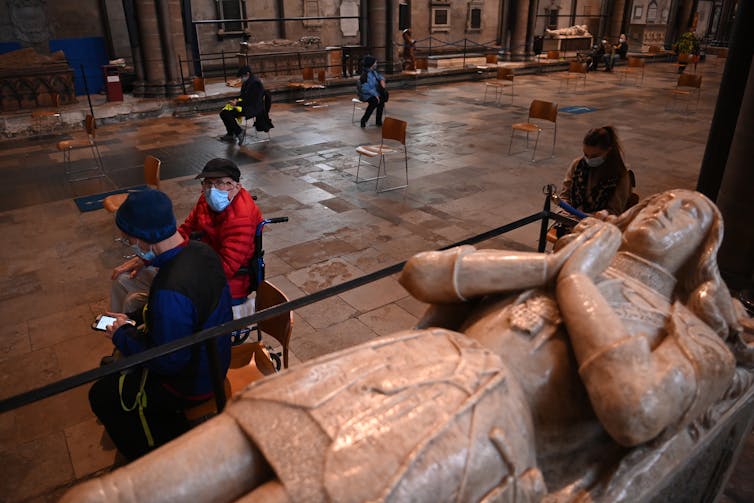The UK’s COVID-19 response has been criticised severely. Britain is among the countries with the highest number of recorded COVID-19 cases and deaths. But with its vaccination campaign, its fortunes seem to have turned.
The UK is one of the world’s front runners when it comes to vaccine coverage. On December 8 2020, it became the first country to start administering a fully trialled and tested COVID-19 vaccine to its citizens. Since then, more than 18 million people in the UK have received a first vaccine dose, with over 600,000 second doses also being administered.
The UK government has pledged that all adults will be offered a vaccine before the end of July. This would be a huge achievement less than eight months after vaccinations began. Initially, this deadline was late autumn, which demonstrates the success of Britain’s initiative to date. The speedier rollout of the vaccine raises hopes for a swifter end to restrictions. Unsurprisingly, rollout so far has been termed a “rare pandemic success”. Here’s how it’s been achieved.
Keeping up supply
The UK government’s end-of-July vaccination target looks achievable, and by maintaining an average speed of 2.9 million vaccinations per week – which is what has been achieved so far – the entire UK adult population could receive both doses by late September. Reaching and maintaining this pace requires consistent vaccine supplies, and the key to this lies in the supply chain.
Supply shortages have plagued vaccine rollouts around the world. A prominent example has been the dispute between the EU and AstraZeneca. The manufacturer drastically cut deliveries of its vaccine, citing production issues.
While the UK and the EU signed broadly similar contracts with AstraZeneca, British negotiators demonstrated a better understanding of the supply chain. The UK contract contains a commitment by AstraZeneca that the British supply chain “will be appropriate and sufficient” for the supply of the doses the country purchased. If its supply chain were to be insufficient at any point, AstraZeneca would need to cover any shortfall from elsewhere in its global network. The EU contract does not contain an equivalent clause.
Committing early to contracts with suppliers has been another positive in the UK’s vaccine procurement, as has the willingness to invest. The UK has spent £11.7 billion on purchasing, manufacturing and deploying COVID-19 vaccines as well as on vaccine research. Kate Bingham, the former chair of the UK COVID-19 vaccine task force, has highlighted that her purchasing strategy focused on which vaccines were being developed quickly rather than cost.
The UK now finds itself in the position of having secured access to seven vaccine candidates and potentially many more doses than it needs. It has already ordered enough doses of the vaccines currently authorised to cover its population. As additional vaccines are approved, its supplies will grow further still.
Manufacturing capacity has been the subject of long-term investment from the British government too. As a result, manufacturing infrastructure was already in place at the beginning of the pandemic and could be scaled up quickly, which resulted in three vaccines being made in the UK, giving ready access to supplies. Quickly kickstarting manufacturing also gave Britain the chance to iron out any production glitches early on; the EU has instead had to resolve these more recently, denting its supplies.
University of Oxford
Long-term research investment has also helped. The UK, unsurprisingly, was at the front of the queue for the vaccine developed by the University of Oxford with AstraZeneca, and has ordered more of this one than others. Oxford scientists had already been researching a vaccine that could be used against a disease like COVID-19. Ready access to large stocks of a working vaccine is somewhat down to research investment that stretches back years.
Planning the distribution
But early investment and clever procurement alone do not account for the success of the UK’s vaccine rollout. They are paired with an excellent distribution network. The centralised structure of the NHS has offered an ideal platform for planning and coordination; but a varied and localised system of delivery has ensured the rollout has been effective.
In England alone there are more than 1,500 vaccination sites. These consist of GP surgeries and community pharmacies at the smaller end through to hospital hubs and mass vaccination centres established in sports centres, race courses and showgrounds. While the larger vaccination hubs offer speedy inoculations for many, the smaller community-based services ensure that access is broad.
This diverse network of vaccination sites does make distribution more challenging. Supplies need to be split among the sites without any one location running out unexpectedly or doses going to waste. Effective planning and stock management is critical, and for this reason, experienced medicines distributors have been brought in to make sure that supplies can continually be delivered.

Neil Hall/EPA-EFE
Indeed, this is part of a wider effort to bundle together the strengths of different organisations and individuals and using their existing capabilities to make the rollout as quick as possible. For instance, alongside industry experts, military logistics planners and personnel have been drafted in to help with distribution.
The COVID-19 vaccine rollout is an unprecedented logistical effort. The UK is currently handling this challenge better than many other countries, which could well learn from it. However, after the high burden of deaths, illness, repeated lockdowns and economic damage, the pressure on the UK to maintain the speed of its rollout is high. The country is still in lockdown, and hopes for an end to restrictions rest on its vaccination campaign’s success.
![]()
The authors do not work for, consult, own shares in or receive funding from any company or organisation that would benefit from this article, and have disclosed no relevant affiliations beyond their academic appointment.











